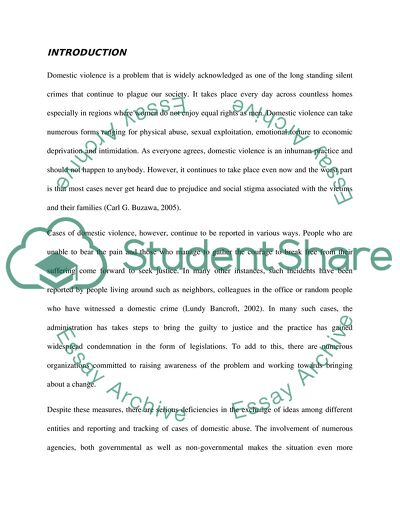
- Home
- Free Samples
- Premium Essays
- Editing Services
- Extra Tools
- Essay Writing Help
- About Us
- Studentshare
- Subjects
- Miscellaneous
- Tailoring a Web based System to the needs of a local Community
Tailoring a Web based System to the needs of a local Community - Essay Example

- Subject: Miscellaneous
- Type: Essay
- Level: Ph.D.
- Pages: 4 (1000 words)
- Downloads: 0
- Author: whitefrances
Extract of sample "Tailoring a Web based System to the needs of a local Community"
Domestic violence is a problem that is widely acknowledged as one of the long standing silent crimes that continue to plague our society. It takes place every day across countless homes especially in regions where women do not enjoy equal rights as men. Domestic violence can take numerous forms ranging for physical abuse, sexual exploitation, emotional torture to economic deprivation and intimidation. As everyone agrees, domestic violence is an inhuman practice and should not happen to anybody.
However, it continues to take place even now and the worst part is that most cases never get heard due to prejudice and social stigma associated with the victims and their families (Carl G. Buzawa, 2005). Cases of domestic violence, however, continue to be reported in various ways. People who are unable to bear the pain and those who manage to gather the courage to break free from their suffering come forward to seek justice. In many other instances, such incidents have been reported by people living around such as neighbors, colleagues in the office or random people who have witnessed a domestic crime (Lundy Bancroft, 2002).
In many such cases, the administration has takes steps to bring the guilty to justice and the practice has gained widespread condemnation in the form of legislations. To add to this, there are numerous organizations committed to raising awareness of the problem and working towards bringing about a change. Despite these measures, there are serious deficiencies in the exchange of ideas among different entities and reporting and tracking of cases of domestic abuse. The involvement of numerous agencies, both governmental as well as non-governmental makes the situation even more complex, thereby requiring a structured approach (Thomas B.
James, 2003). It has also been observed that the exchange of information in this scenario cannot
...Download file to see next pages Read MoreCHECK THESE SAMPLES OF Tailoring a Web based System to the needs of a local Community
Management Planning
The Consumer Decision-Making Process as It Relates to Replacing a Laptop Computer
Zaras E-Tailing Plan
League Table Management System
Recommendation paper about google
International human resource and organizational behavior
Main Aspects of Management Planning
Buyer Behaviour: The Consumer Decision-Making Process as it relates to Replacing a Laptop Computer

- TERMS & CONDITIONS
- PRIVACY POLICY
- COOKIES POLICY